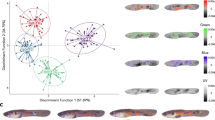Summary
Two cases of mosaic (dark-eyed intense—pink-eyed dilute) pelage patterns are reported in the house mouse. The unusual colour was not inherited by descendants. A direct correlation between the mosaic pattern of the coat and the pattern of piebald white-spotting in this strain of mice was observed. Aberrant chromosome division in somatic tissue is suggested as an explanation of these mosaics.
Similar content being viewed by others
References
Bittner, J. J. (1932). “A colour-mosaic in the mouse.”J. Hered.23, 421–3.
Castle, W. E. (1912). “On the origin of a pink-eyed guinea-pig with coloured coat.”Science, N.S.35, 508–10.
-- (1922).On a non-transmissible tricolour variation in rats. Publ. Carneg. Instn, No. 320, Partii, pp. 51–4.
—— (1924). “Genetics of the Japanese rabbit.”J. Genet. 14, 225–9.
—— (1929). “A mosaic (intense-dilute) coat pattern in the rabbit.”J. exp. Zool. 52, 471–80.
Fisher, R. A. (1930). “Notes on a tri-colour (mosaic) mouse.”J. Genet.23, 77–81.
Ibsen, H. L. (1916). “Tricolour inheritance.”Genetics,1, 287–309.
Mohr, O. L. (1923). “A somatic mutation in the singed locus of theX-chromosome inDrosophila melanogaster.”Hereditas,4, 142–60.
Morgan, T. H. andBridges, C. B. (1919).The origin of Gynandromorphs. Publ. Carneg. Instn, No. 278, pp. 1–123.
Muller, H. J. (1920). “Further changes in the white-eye series ofDrosophila and their bearings on the manner of occurrence of mutation.”J. exp. Zool.31, 443–72.
Pincus, G. (1929). “A mosaic (black-brown) coat pattern in the house mouse.” Ibid.52, 439–41.
Whiting, P. W. (1928). “Mosaicism and mutation inHabrobracon.”Biol. Bull. Wood’s Hole,54, 289–307.
Whiting, P. W. andWhiting, Anna R. (1927). “Gynandromorphs and other irregular types inHabrobracon.” Ibid.52, 89–121.
Wright, S. andEaton, O. N. (1926). “Mutational mosaic coat patterns of the guinea-pig.”Genetics,11, 333–51.
Author information
Authors and Affiliations
Additional information
Observations reported in this paper were made in the Laboratory of Vertebrate Genetics, University of Michigan.
Rights and permissions
About this article
Cite this article
Feldman, H.W. A mosaic (dark-eyed intense—pink-eyed dilute) coat colour of the house mouse. Journ. of Genetics 30, 383–388 (1935). https://doi.org/10.1007/BF02982246
Issue Date:
DOI: https://doi.org/10.1007/BF02982246




